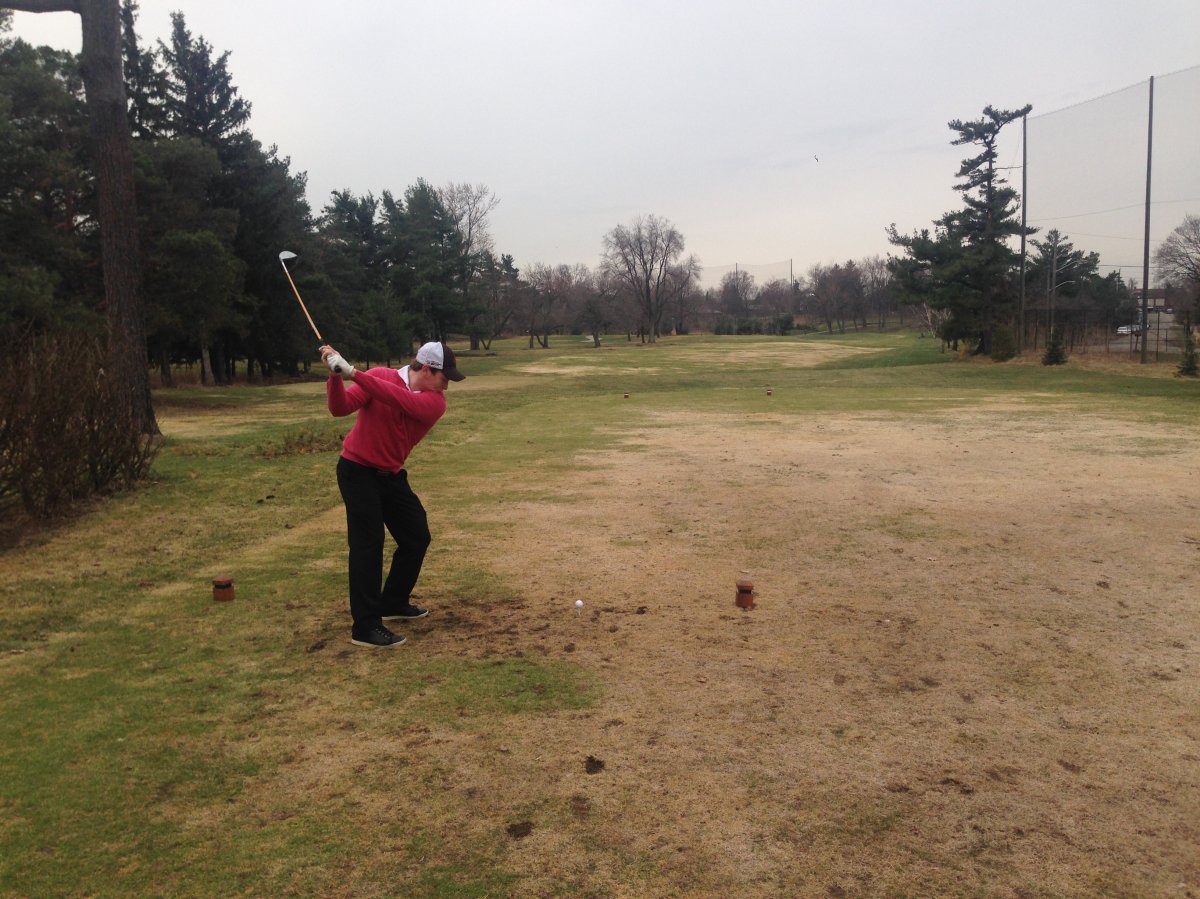Dave Kuypers is pleased to just be opening his course.

Kuypers, the superintendent of Cutten Fields in Guelph, Ont., has struggled with ice damage on much of the green.
“Golfers will be out playing this weekend,” he says. “They won’t be putting on greens though.”
Cutten Fields, a historic private course, is one of numerous Ontario golf facilities that faced an unusual amount of damage from ice and the extreme cold that occurred through to the end of March.
READ MORE: Toronto golf courses in the rough, but open for business
Most golf courses are open in April in Ontario. This year many are just opening in coming days, while others have opened with damaged greens that are brown because the Poa annua grass died after being under ice for more than 45 straight days.
Owen Russell knew he had a problem when the smell hit him.
Russell, the superintendent at Markland Woods in Etobicoke, Ont. for the past eight years, ventured out on his course in February, worried about the impact of ice and cold on his club’s greens. Like many superintendents concerned about how the coldest winter in the last three decades would affect his course, Russell drilled through the ice to see what was happening with the grass underneath.
“I knew from the smell that we had a problem,” he says. “It smelled bad, sort of like rotten eggs.”
WATCH: Conditions were questionable as Toronto’s public golf courses opened for the season in April.
By the time Markland Woods’ greens were clear, Russell recognized the extent of the damage brought by the extreme cold. On most greens at least 50% of the grass was damaged or dead, and that amount rose to more than 70% on other greens.
“There was nothing we could do,” says Russell. “If we cleared them the temperatures were so cold we may have created more problems. It was a mess.”
What Markland Woods experienced is now being felt across Ontario courses where Poa is the covering for their greens.
The damage to golf courses is widespread not only in Ontario, but across the northern U.S. as well. In Ontario some of the best-known golf courses—from host courses of the RBC Canadian Open like St. George’s to Hamilton Golf and Country Club through to modest public courses like Guelph’s Victoria Park East—have been hit by extensive damage. The cold, it turns out, doesn’t discriminate based on the cost of the green fee—it killed Poa greens regardless.
“I’ve never seen anything like it in the 25 years I’ve been in the business,” says Rhod Trainor, the superintendent at Hamilton where he’s prepared the golf course for three PGA Tour events. “It is like something out of a textbook. It is just a freak thing.”
The problems facing golf courses with Poa greens have different names, but the result is the same. Hit hard by a the coldest winter in years, Poa grasses were damaged by crown hydration, whereby grass takes in water and is hit by a sudden freeze; winter desiccation, which is essentially dehydration due to constant exposure to exposed, higher areas; depleted oxygen by anoxia; low temperatures; and ice. In some instances, superintendents say they were hit by all four problems, something that has never occurred before.
READ MORE: Long winter may have lasting effects across Ontario
Now Ontario superintendents face decisions on how to deal with the difficult hand Mother Nature has dealt them. Do they reseed the greens with a strain of bent grass that will be more resilient to Ontario’s harsh winters, or do they try to grow Poa and reestablish it in the hope they don’t face a recurrence of the stunning cold?
“There’s one fix for this and that’s to grow bent grass,” says USGA agronomist Adam Moeller, who has been consulting with Ontario courses about the damage. “It is really your most reliable insurance policy, but it comes with a cost.”
Keith Bartlett, superintendent at St. George’s, has problems with Poa damage on most of the club’s greens, though he hopes to have most of the greens open by mid-June. Bartlett, who has worked as a superintendent for 22 years, says bent grass is the only true solution to the possibility of winter damage in Ontario. He adds that bent grasses take less water, fewer fertilizers, and create a better playing surface.
“To me this problem we’re facing is a wake-up call to the industry,” he says. “We’re just kidding ourselves if we think this won’t happen again.”
Like other supers, David DeCorso has tough decisions to make. DeCorso is the superintendent at Victoria Park East, a 40-year old public course.
The course, like many of its age, has Poa greens, many of which have varying levels of damage from the ice and cold. Victoria Park East is owned by the DeCorso family, as is a newer course, Victoria Park Valley. The new course, with its bent grass greens, had no issues from the winter, but on the east course DeCorso has opened the season with three greens closed, and nine with tarps covering large sections as he attempts to grow grass. Closing the course to reseed with bent grass or sod the damaged greens isn’t financially viable, he explains, especially in a market where the long winter has already cut into paid rounds.
“This isn’t like the old days when the business had money for capital projects,” says DeCorso, who has been a superintendent for 22 years. “There’s not a lot of money to go around and we can’t afford the long-term solution of closing the course to solve the problem.”
DeCorso says many golfers have shrugged off this year’s problem as typical of Ontario courses during a long winter. But the situation is much more severe than other years, he points out, and he wonders if golfers will feel so charitable if public courses don’t recover by June.
“They are going to get impatient,” he says. “And they’ll make their point known by not spending their money at certain courses.”
At Cutten, Kuypers prepares to head back out to continue working on his course. He hopes by June, with some warm weather, the greens will be greatly improved. But for many clubs, losing a month of play and having damage to their facilities will be a difficult hurdle to overcome.
“It is really hard for a lot of clubs,” he says. “It is a tough time to be in the golf business.”




Comments